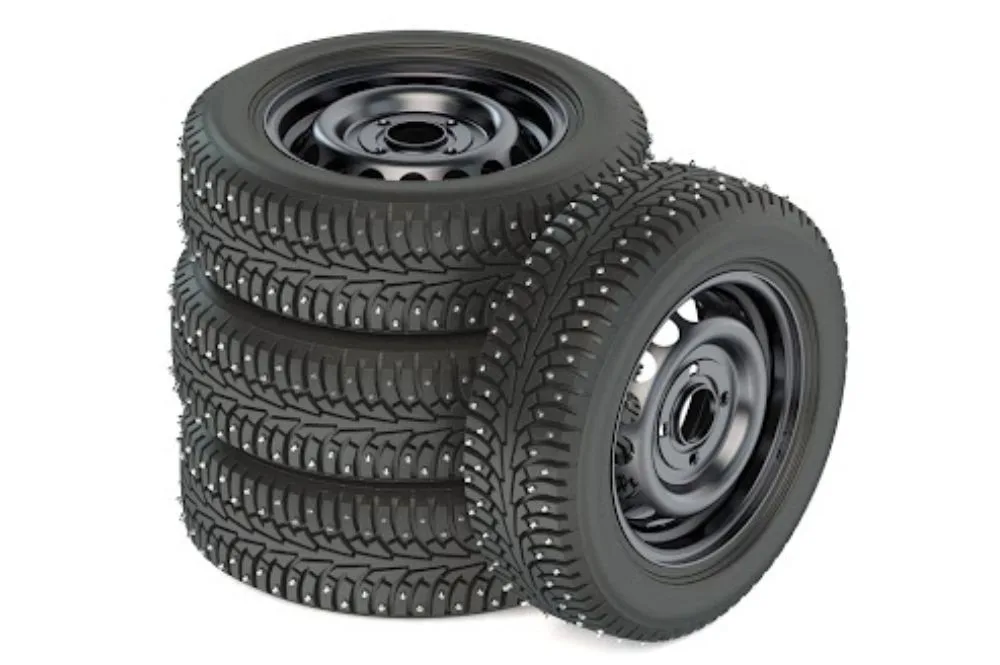What are studded winter tires?

Studded winter tires are a type of winter tire that has metal studs embedded in the rubber. These metal studs help provide traction on icy and snowy surfaces.
Most studded winter tires are made with carbide tips, which are designed to wear down slowly as they come into contact with the road. This helps minimize the amount of noise that the tires make, and also helps to protect the roadways from damage.
Studded winter tires are not legal in all provinces, so be sure to check the laws in your area before purchasing them.
THE BENEFITS OF STUDDED WINTER TIRES
While studded winter tires have been around for a while, they continue to be a source of contention among drivers. Some love them for their excellent traction and peace of mind in winter driving conditions, while others view them as a noisy nuisance. Regardless of your opinion, it’s important to be informed about the pros and cons of studded winter tires before making a decision about whether or not to use them.
There are two main types of studs for tires – metal studded and carbide-tipped. Metal-studded tires have steel spikes embedded in the tread, while carbide-tipped tires have tips made of harder material like tungsten or titanium. Both types of studded tires are designed to provide excellent traction on ice and snow-covered roads.
One of the key benefits of studded winter tires is their improved traction compared to non-studded winter tires. The metal or carbide spikes dig into the ice and provide added grip, making it easier to maintain control on slippery roads. This can be particularly useful when driving on untreated roads or in rural areas where road maintenance is not as regular. In addition, studded winter tires tend to perform better than non-studded alternatives in very cold temperatures when ice and snow are most prevalent.
Another benefit of using studded winter tires is increased safety. The added traction can help you avoid accidents by giving you more control over your vehicle in treacherous conditions. This can give you peace of mind when driving in winter weather and can ultimately make roads safer for everyone by reducing the number of accidents that occur each year.
Despite these benefits, there are also some drawbacks to using studded winter tires that you should be aware of before making a decision about whether or not to use them.
One downside is that they can be noisy, particularly at lower speeds. The spikes may also damage asphalt surfaces over time, which is why some areas have banned their use altogether (or only allow them to be used during certain months).
In addition, they tend to be more expensive than non-studded alternatives and may require more frequent replacement due to wear and tear from the metal spikes.
Whether or not to use studded winter tires is ultimately a personal decision that depends on individual circumstances. If you live in an area with severe winters and lots of snow and ice, they may be worth the investment for the added safety and peace of mind they provide. However, if you live in a milder climate or don’t mind sacrificing some traction for a quieter ride, non-studded options may be a better choice.
HOW TO CHOOSE THE RIGHT STUDDED WINTER TIRES FOR YOUR VEHICLE
There are three main types of studded winter tires: those with metal studs, those with ceramic studs, and those with carbide-tipped studs. Each type has its own benefits and drawbacks.
Metal-studded tires are the most common type of studded winter tire. They provide excellent traction on icy and snow-covered roads, but they can damage pavement, so they are not recommended for use on bare roads.
Ceramic-studded tires are a newer type of studded winter tire. They provide excellent traction on icy and snow-covered roads, and they are less likely to damage pavement than metal-studded tires. However, they are more expensive than metal-studded tires.
Carbide-tipped studded tires are the newest type of studded winter tire. They provide excellent traction on icy and snow-covered roads, and they are less likely to damage pavement than metal-studded or ceramic-studded tires. Carbide-tipped studded tires are also more expensive than metal- or ceramic-studded tires.
Are Studded Tires Worth It?
Depending on where you live, studded snow tires can be an excellent choice for your winter driving. If you live somewhere that sees a lot of extreme weather, has poor road conditions or limited road maintenance, or you drive off-road, studded tires can give you added comfort and safety.
In stock & ready to ship
Find the tires you need, delivered from a warehouse near you
